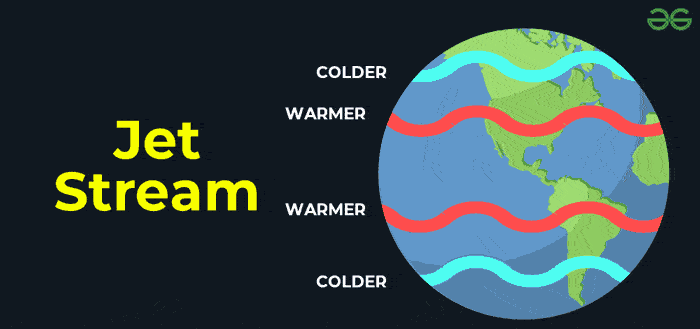What are Jet Streams and How do they Affect the Climate of India?
Last Updated :
28 Jun, 2023
Jet streams refer to the narrow belt of high altitude, mostly above 12,000 meters, westerly winds in the troposphere and they come to affect the climate of India in many ways. The westerly jet streams tend to bring western cyclonic disturbances which enter the subcontinent of India from the west as well as northwest part during winter months. Easterly jet streams are also known as sub-tropical easterly jet streams and blow over peninsular India, tropical cyclones tend to occur in monsoon and also October- November because of the presence of easterly winds.

Jet Streams
Jet Streams
Jet streams are the quick streaming, narrow, and wandering air currents that flow in the atmosphere of Earth. They generally are situated close to the altitude of the tropopause and are westerly breezes (streaming west to east) because of the Coriolis Effect (developments of water and air currents and flows initiated because of the revolution of the earth).
An air current is a streaming development of air inside a bigger collection of air; they flow in the layers of air surrounding the Earth. They are shaped because of the uneven heating of the Earth by the sun. As the warmed air grows because of warming it becomes lighter than the surrounding air; in this way, it rises and makes a warm air current. Cooler and heavier air then step in to replace the emerged warm air in this way shaping a cool air current. Jet streams are the air currents found in the highest part of the atmosphere.
Jet Streams Affect the Indian Climate
The jet streams affect the climate of India:
- They impact the environment of India as the westerly Jet stream prevails over the North Indian Plains throughout the cold weather months, while the easterly Jet stream directs the tropical misery over India.
- These sorrows assume a huge part in the distribution of monsoon rainfall in the subcontinent. The highest rainfall happens along the track of these depressions.
- In winter, there is to a greater extent a temperature contrast between the equator and poles, so the Jet stream is more grounded and streams over the UK. To this end we will more often than not see wetter climates.
- The opposite is valid in summer, where there will in general be a more modest temperature distinction. The place Jet stream normally winds up toward the north of the UK and we see more quiet drier climate.
- Although the position and level of the Jet stream transform, it basically moves around at a comparative level to that of overseas airplanes. If you somehow happened to fly along the progression of the Jet stream it would be faster and save fuel.
- Jet streams can get fairly uneven too, particularly where the breeze changes its speed, or when the stream isn’t straight. This beats up the air a piece like changes in a stream, so choppiness is another, frequently unwanted part of air travel.
Related Links
- Climate of India
- Factors Affecting the Climate of India
- Regional variations in climatic conditions of India
- Western Disturbances in Indian Climate
Frequently Asked Questions
Q 1. What is the Jetstream and for what reason is it essential to our climate?
Answer-
The Jet stream streams high above and causes changes in the breeze and strain at that level. This influences things closer to the surface, like areas of high and low strain, and consequently assists shape the climate we with seeing. Once in a while, as in a fast-moving river, the Jet stream’s development is extremely straight and smooth.
Q 2. What are the significant effects of Jet streams?
Answer-
The slower and faster rate of with drawl leads to late and early onset of southwest monsoon. The intensity of monsoon rainfall: The arrival of tropical easterly jet streams influences the intensity of southwest monsoon. This leads to the increasing intensity of rainfall during the southwest monsoon.
Q 3. How do Jet streams influence the environment?
Answer-
The quick air currents and flows in a jet stream can move climate frameworks across the United States, influencing temperature and precipitation. Be that as it may, assuming that a climate framework is far away from a fly stream, it could remain in one spot, causing heat waves or floods.
Like Article
Suggest improvement
Share your thoughts in the comments
Please Login to comment...